The Economics and Statistics Division maintains archives of previous publications for accountability purposes, but makes no updates to keep these documents current with the latest data revisions from Statistics Canada. As a result, information in older documents may not be accurate. Please exercise caution when referring to older documents. For the latest information and historical data, please contact the individual listed to the right.
<--- Return to Archive
For additional information relating to this article, please contact:
March 07, 2025LABOUR MARKET TRENDS, FEBRUARY 2025 February labour force survey results reflect the period from February 9 to 15, 2025.
Ages 15+ (February 2025 vs January 2025, seasonally adjusted)
Nova Scotia's seasonally adjusted employment fell by 4,300 (-0.8%) to 522,900 in February following a decline of 500 (-0.1%) in the previous month.
The change in employment was attributable to a decline in part-time employment (-5,700) that offset a gain in full-time employment (+1,500). Note that changes in full-time and part-time employment can also reflect changing hours for the same job.
Nova Scotia’s labour force fell by 400 (-0.1%) to 560,000 in February 2025.
With employment falling faster than labour force, Nova Scotia's unemployment rate increased 0.7 percentage points to 6.6% in February 2025.
Nova Scotia's labour force participation rate edged down 0.1 percentage point to 61.5% and the employment rate fell 0.6 percentage points to 57.4% in February 2025.
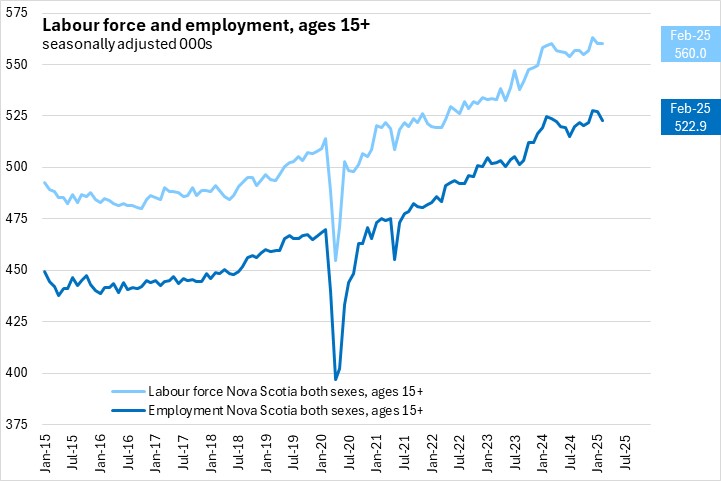
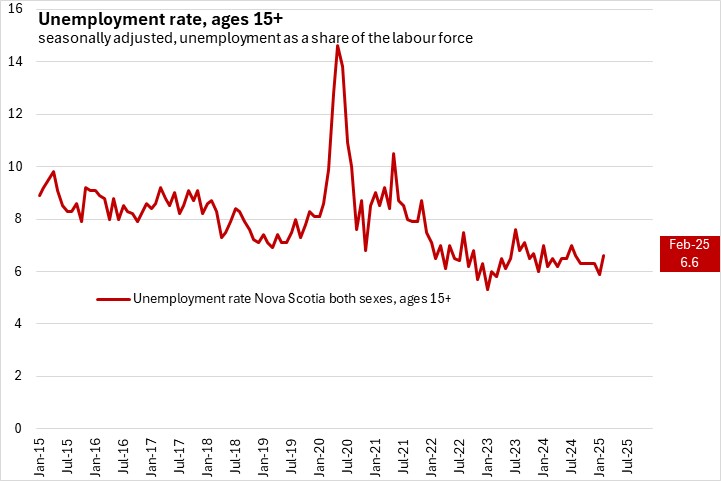
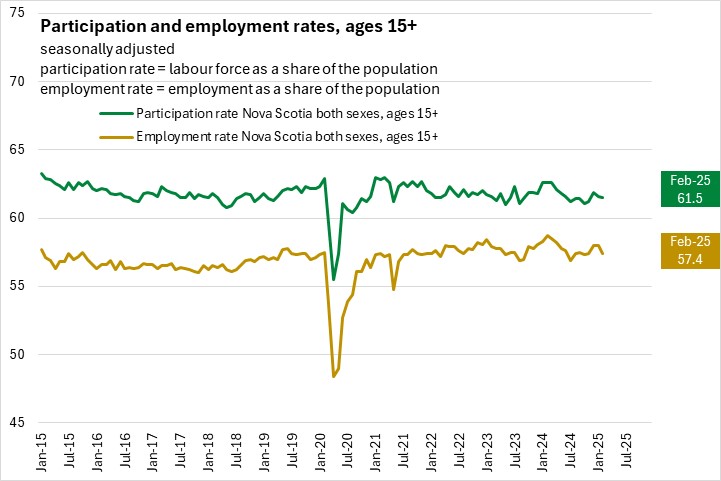
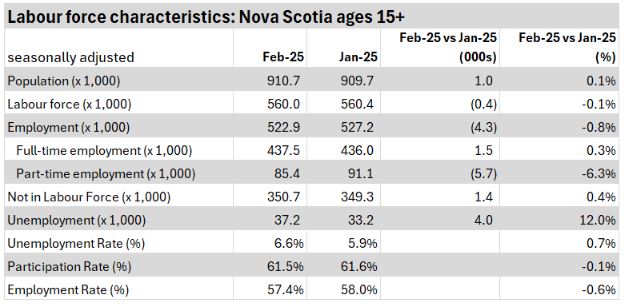
Ages 15+ (February 2025 vs February 2024, seasonally adjusted)
Compared with February 2024, Nova Scotia's population over the age of 15 increased by 17,000 (+1.9%), while the labour force grew by 900 (+0.2%), and employment declined by 1,800 (-0.3%). The unemployment rate increased by 0.4 percentage points while the participation rate fell by 1.1 percentage points and the employment rate fell by 1.3 percentage points.

Ages 15+ (January-February 2025 vs January-February 2024, seasonally adjusted)
Compared with January-February 2024, Nova Scotia's population over the age of 15 increased by 17,800 (+2.0%), while the labour force grew by 1,500 (+0.3%), and employment increased by 3,000 (+0.6%). The unemployment rate fell by 0.4 percentage points, while the participation rate fell by 1.1 percentage points and the employment rate fell by 0.8 percentage points.
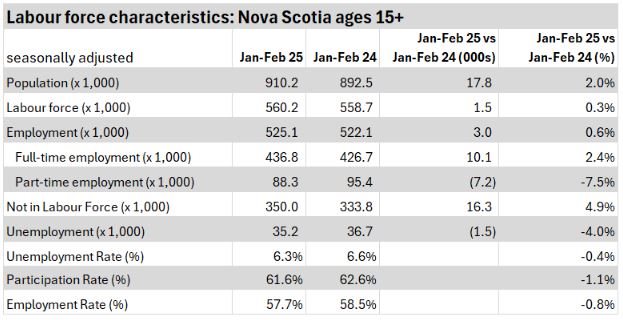
Note: Year-to-date estimates are calculated as averages of monthly data and rounded to the nearest tenth. Year-to-date changes in the table are also rounded to the nearest tenth.
Age Cohorts (February 2025 vs January 2025, seasonally adjusted)
Among youth (ages 15-24), employment was down 2,100 (-3.0%) while the labour force fell by 3,400 (-4.3%). As employment fell slower than the labour force, the youth unemployment rate declined 1.1 percentage points to 11.9% in February 2025. The youth participation rate fell 2.8 percentage points to 64.2% while the youth employment rate was down 1.7 percentage points to 56.6%.
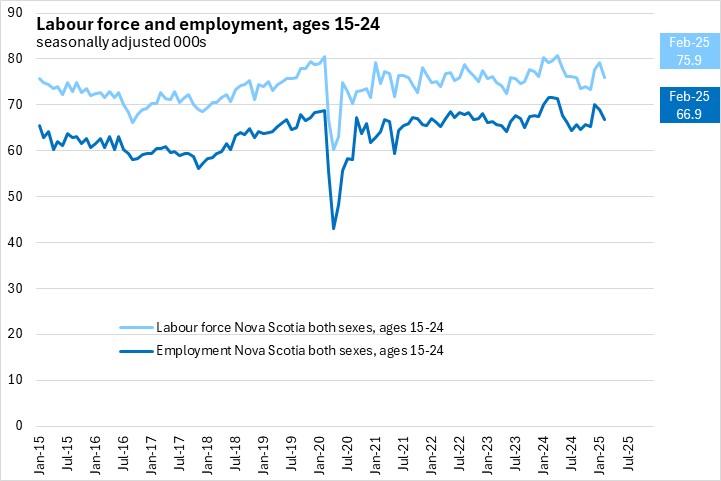
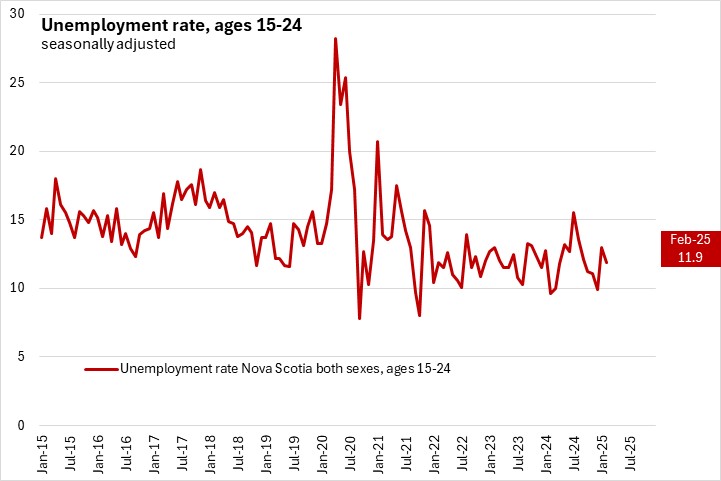
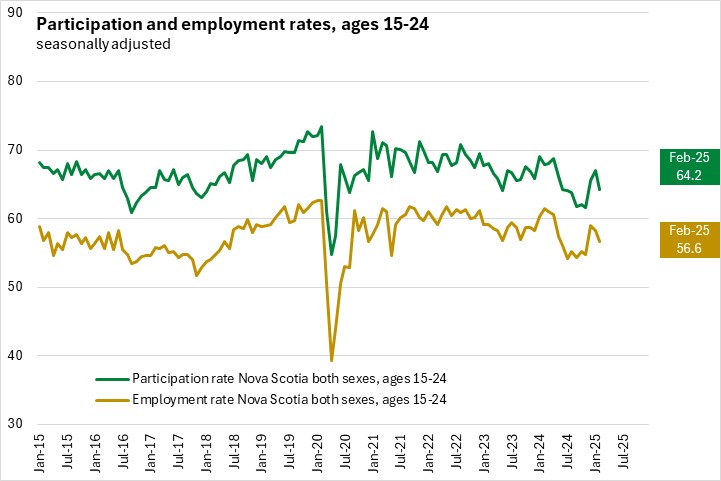
The population aged 25-54 makes up the largest part of the labour force. In the core age group, employment was down 600 (-0.2%) while the labour force rose by 2,600 (+0.7%). With employment falling and the labour force rising, the core aged unemployment rate rose 0.8 percentage points to 5.8% in February 2025. The core aged participation rate increased 0.5 percentage point to 87.5% and the core aged employment rate was down 0.3 percentage points to 82.4%.
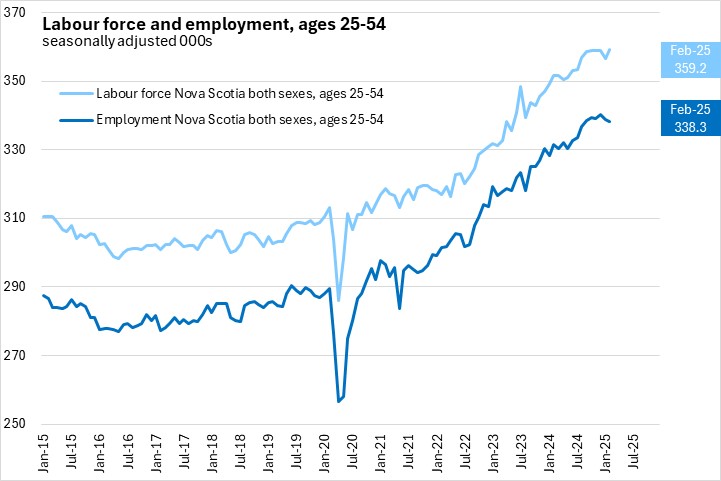
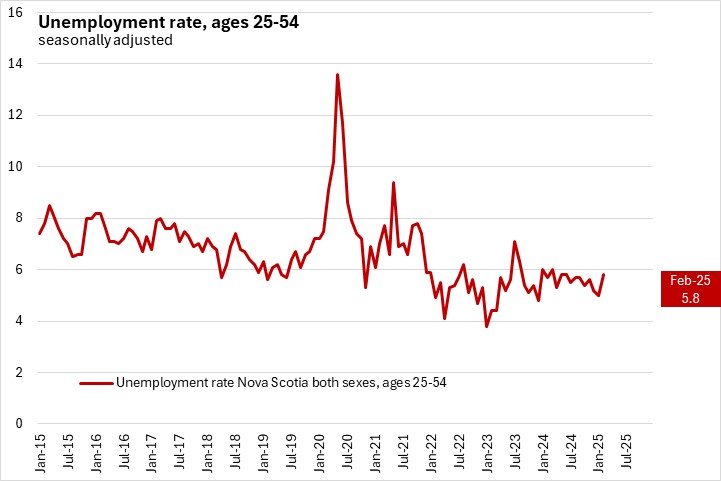
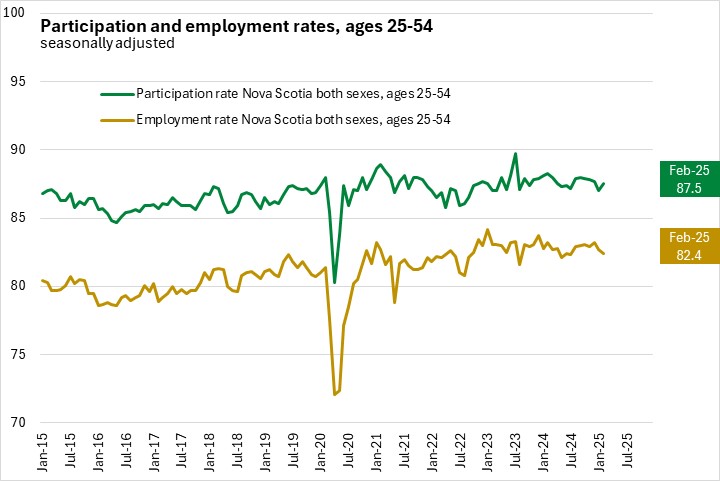
Among older workers (aged 55+) the labour force increased by 400 (+0.3%) while employment fell by 1,700 (-1.4%). With the labour force rising while employment fell, the older worker unemployment rate increased 1.7 percentage points to 5.8%. The older worker participation rate rose 0.1 percentage points to 32.7% and the employment rate for older workers fell 0.5 percentage points to 30.8%.
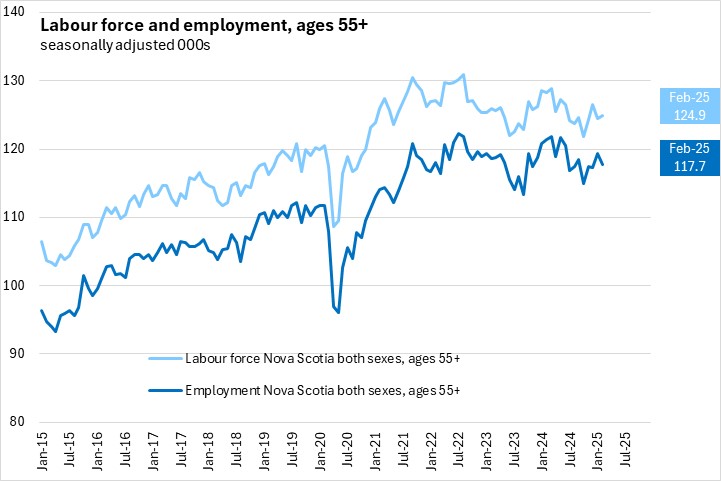
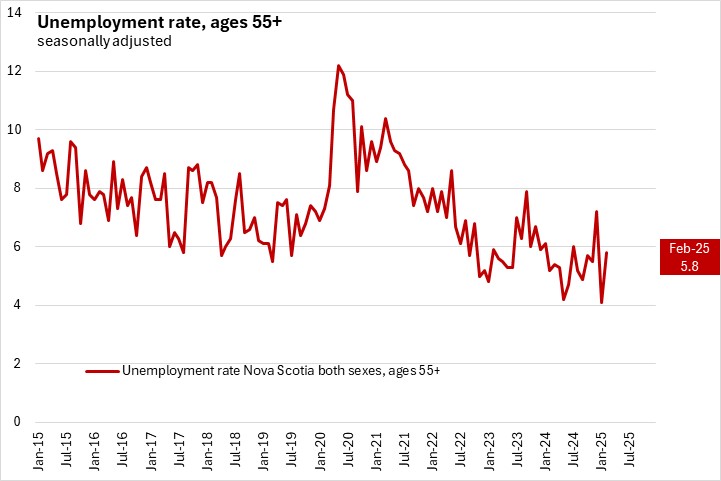
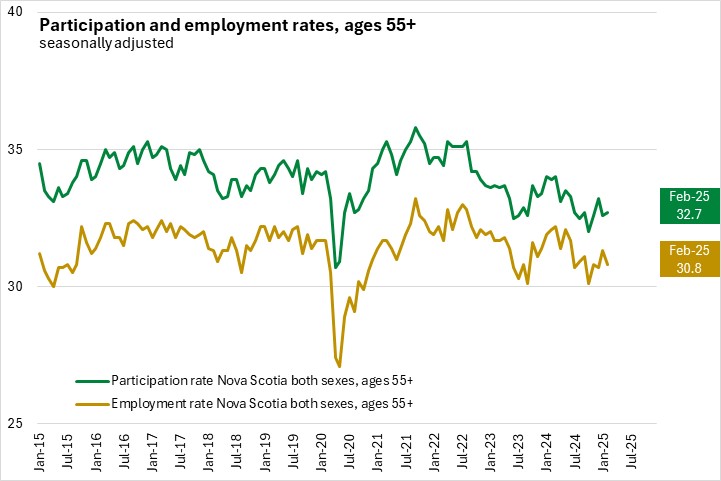
Males and Females (Ages 15+, February 2025 vs January 2025, seasonally adjusted)
Monthly employment declined by 2,100 (-0.8%) for males while the labour force increased by 700 (+0.2%) from January. With employment falling while the labour force increased, the male unemployment rate rose 0.9 percentage points to 7.5% in February. The male participation increased by 0.1 percentage points to 64.8%, while the employment rate declined by 0.5 percentage points to 60.0%.
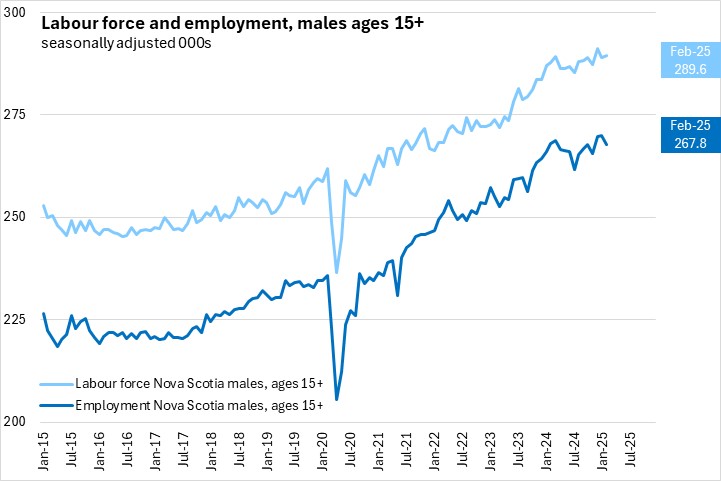
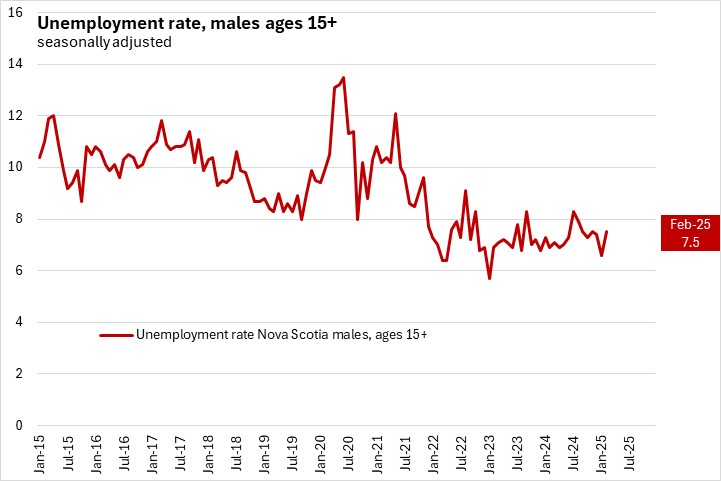
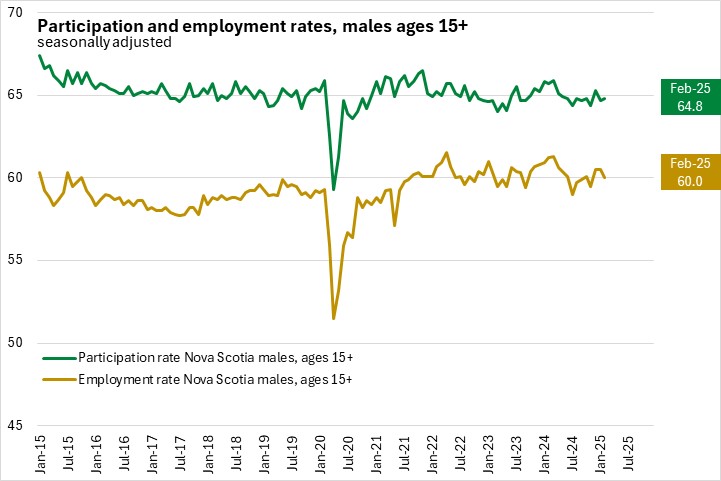
Females reported an employment decline of 2,300 (-0.9%) and a labour force decline of 1,200 (-0.4%). With employment falling faster than labour force, the female unemployment rate rose 0.4 percentage points to 5.7% in February. The female participation rate fell by 0.3 percentage points to 58.3% and the female employment rate fell by 0.5 percentage points to 55.0%.
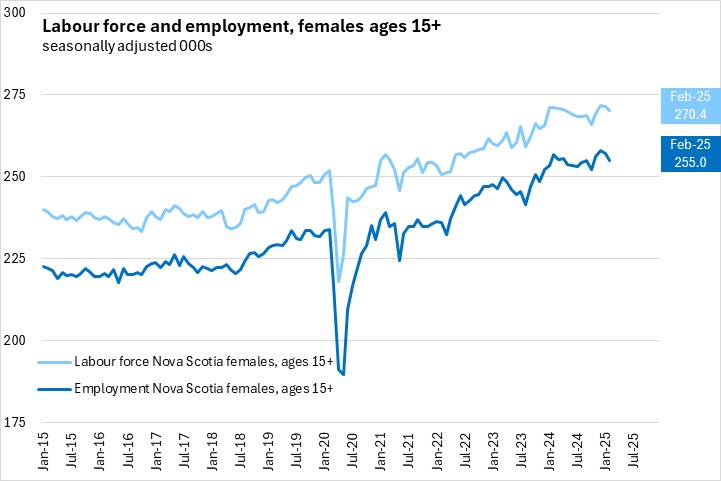
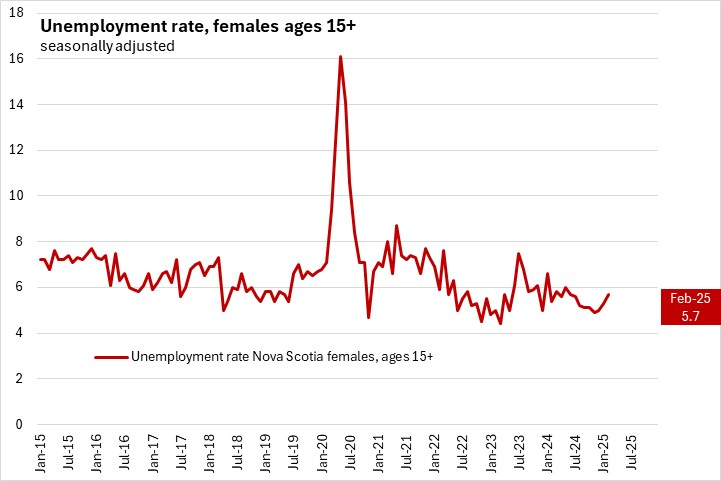

February's decline in employment was primarily due to lower employment among non-core aged workers. Male and female employment fell by similar amounts. The decline in labour force was driven by a decline in younger workers, which was partially offset by an increase in core-aged workers, and to a lesser extent by an increase in older workers.
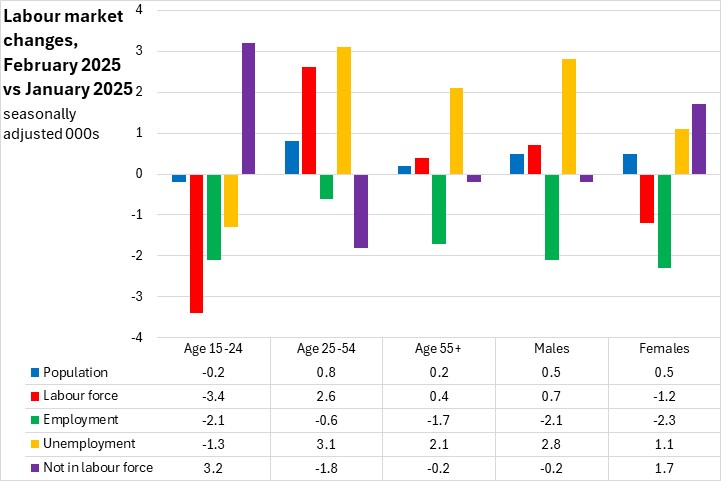
Age and sex cohorts (February 2025 vs February 2024, seasonally adjusted)
Compared with February 2024, employment growth was strongest among core-aged workers (whose population has also grown the most over this period). Youth and older workers had similar labour force losses compared to one year ago while youth experienced a slightly stronger employment loss compared to older workers. Female employment has decreased more than for males when compared to February 2024, while more females are also exiting the labour force than males.

Age and sex cohorts (January-February 2025 vs January-February 2024, seasonally adjusted)
Compared with January-February 2024, labour force and employment growth was highest among core-aged workers (whose population is also growing more than others). Labour force growth lagged employment growth for core-aged workers. Older workers saw a smaller decline in employment than labour force. Core-aged and older workers saw similar declines in unemployment, while younger workers saw increasing unemployment levels. Population, labour force, and employment have increased more for males than females compared to January-February 2024. Year-to-date unemployment declines were concentrated among females, with no change for males.
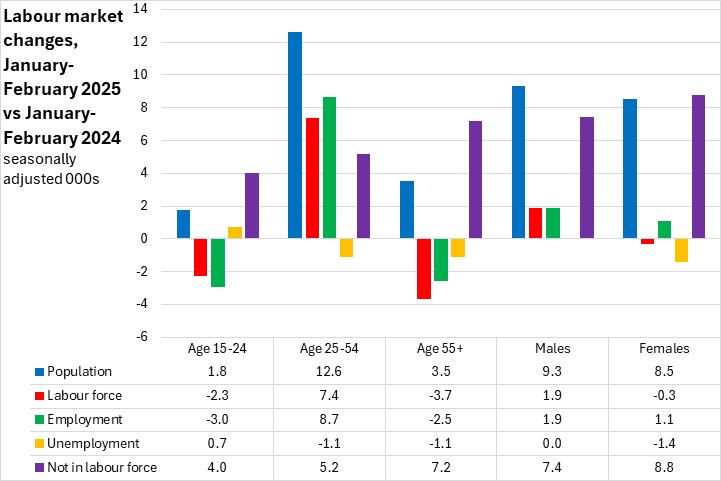
Class of Worker and Industry (February 2025 vs January 2025, seasonally adjusted)
The February 2025 employment change was due to decreases among public sector (-1,000, -0.7%) and private sector (-4,500, -1.4%) workers. Self employment increased by 1,100 (+2.1%) in February.
Classified by industry, the largest employment gains from January to February were in construction, wholesale/retail, and information/culture/recreation. The fastest declines were in agriculture, manufacturing, health/social and professional/technical services.
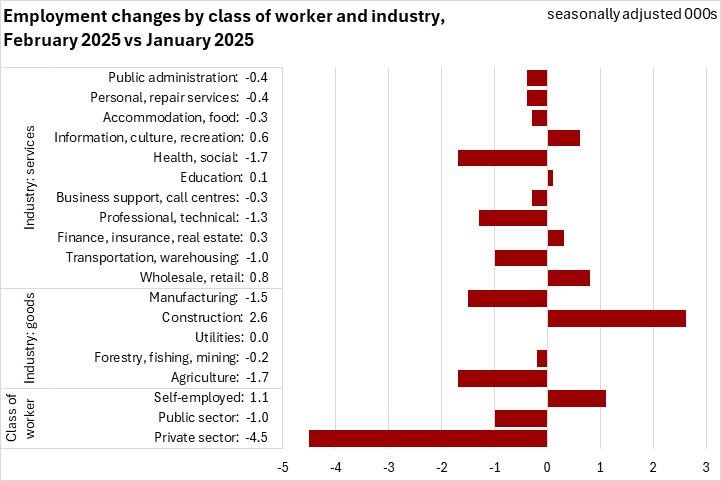
Class of Worker and Industry (February 2025 vs February 2024, seasonally adjusted)
Compared to February 2024, there were employment losses for private sector workers (-10,800 or -3.2%), with gains for public sector workers (+8,300 or +6.3%) and the self-employed (+700 or -1.3%).
Over the last 12 months, employment was up the most for construction, health/social assistance, and accommodation/food services. The largest declines were in wholesale/retail, personal/repair services, manufacturing and professional/technical services.
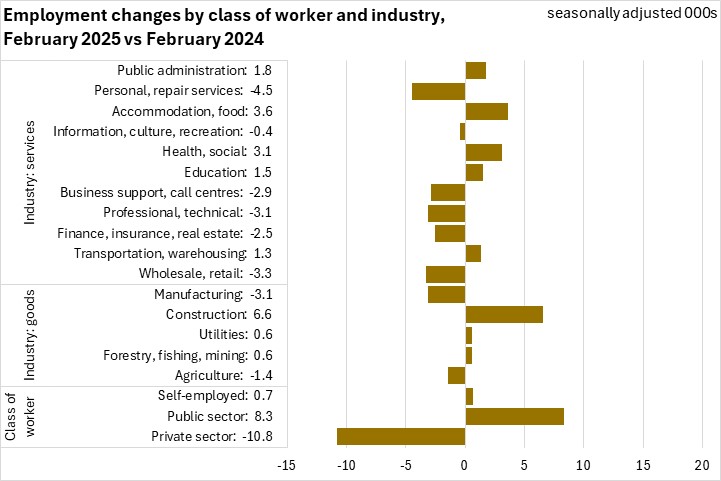
Class of Worker and Industry (January-February 2025 vs January-February 2024, seasonally adjusted)
Compared to January-February 2024, gains were strongest for public sector workers (+9,500 or +7.2%), with no change in self employment. There was a decline in private sector workers (-6,400 or -1.9%).
Gains in employment were strongest in construction, accommodation/food services and health care/social assistance. The largest declines were in personal/repair services, wholesale/retail and finance/insurance/real estate.
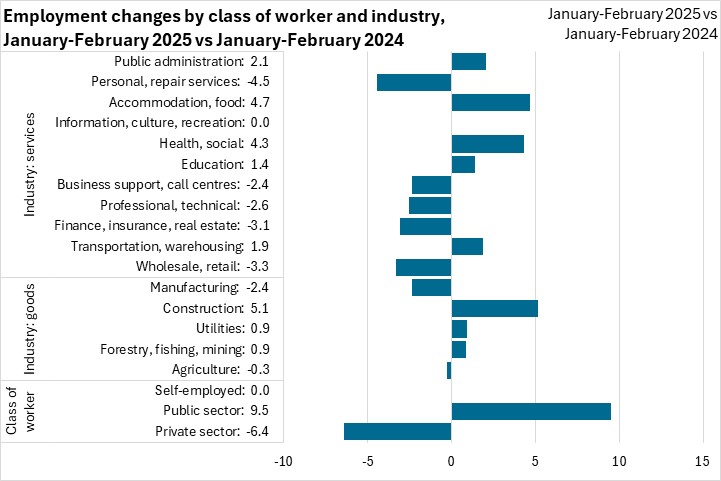

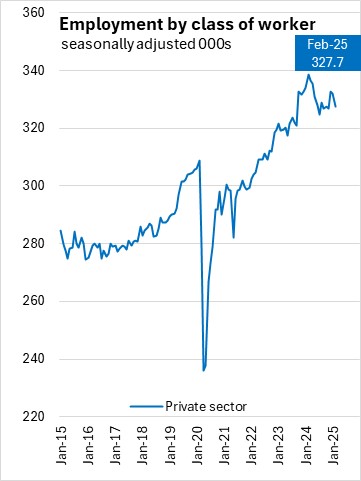
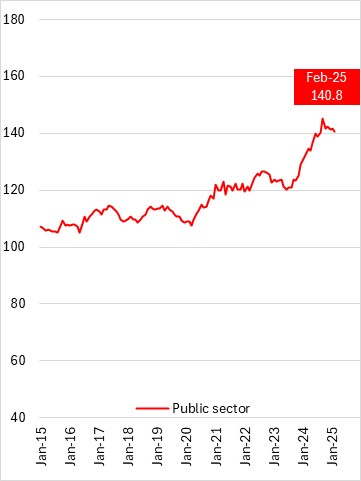
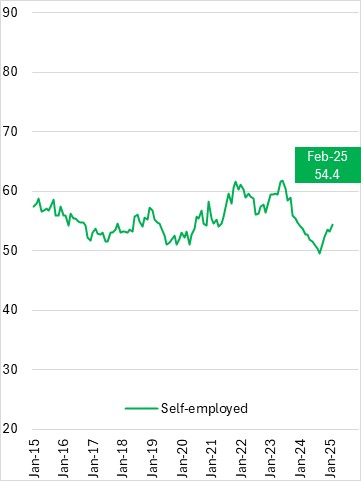
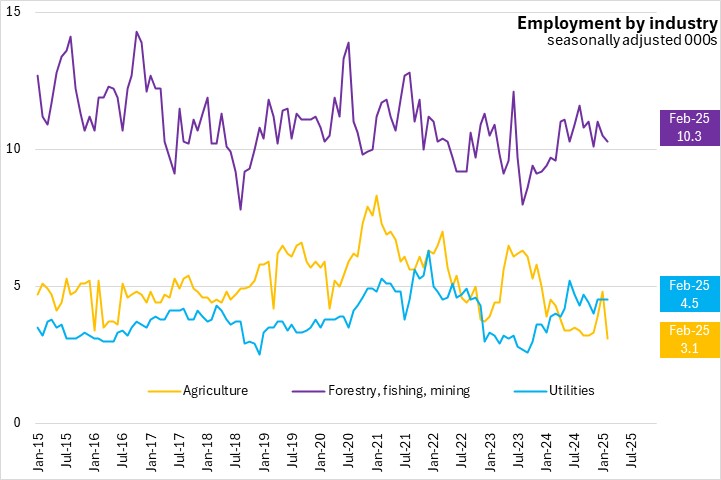
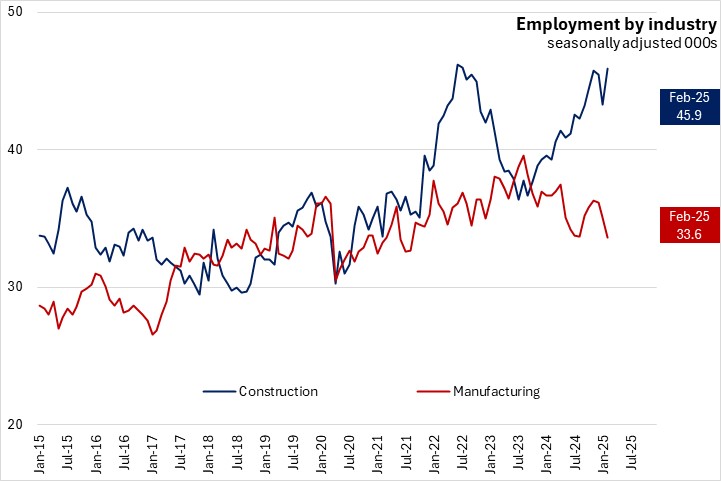
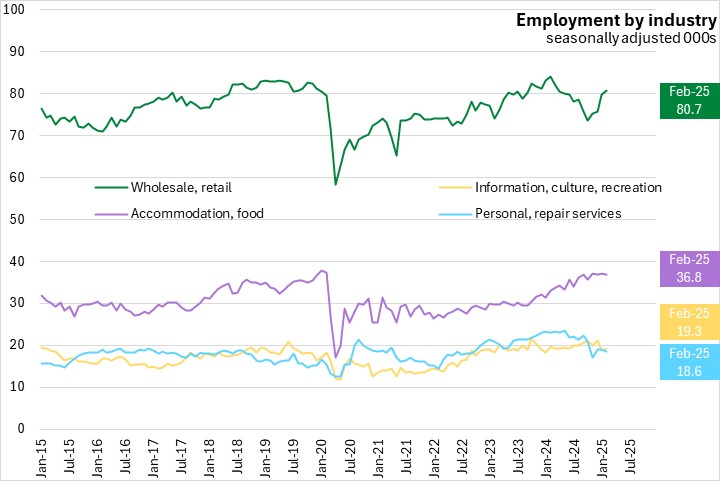
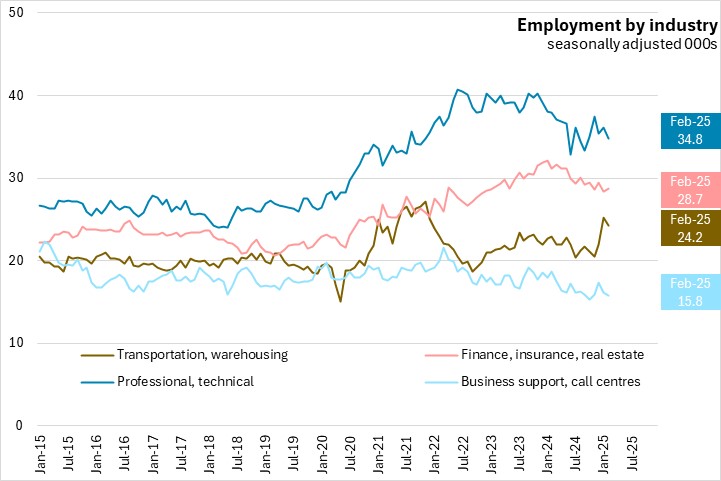
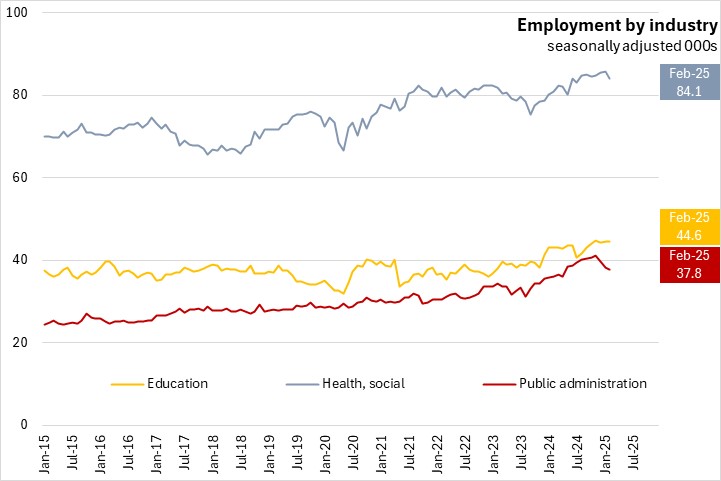
Hours worked and employment (February 2025, unadjusted)
Compared to the provincial average, a larger share of workers in goods producing industries (except utilities), as well as transportation/warehousing, business support/call centers, education and personal/repair services worked more than 40 hours per week in February 2025.

Note that some data on those working few hours in business support (including call centres), utilities, forestry/fishing/mining and agriculture were suppressed.
Average weekly earnings (unadjusted, both full time and part time, February 2025 vs February 2024)
Average weekly earnings increased by 6.1% from February 2024 to February 2025. The fastest gains in average weekly earnings were in information/culture/recreation, business support/call centres, wholesale/retail and education. The largest declines in average weekly wages were in utilities, followed by professional/technical services.
The increase in Nova Scotia's all items consumer price index was 1.3% from January 2024 to January 2025.
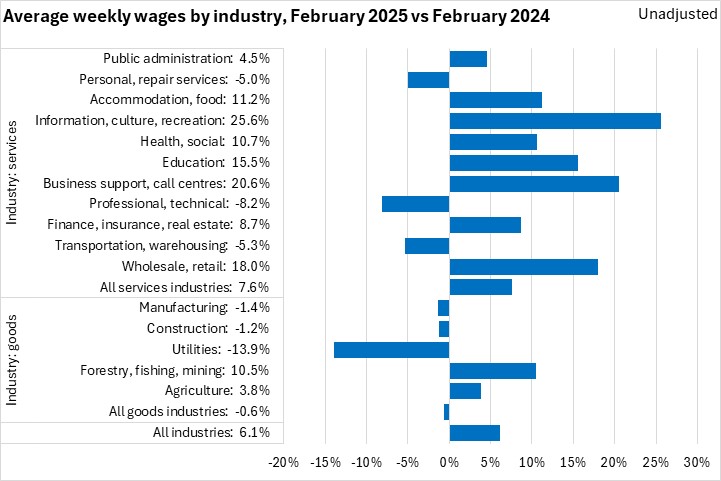
Average weekly earnings across all employees were $1,176.85 in February 2025. The highest average weekly earnings (both full and part time employees) were reported in utilities, professional/technical services, and public administration. The lowest average weekly earnings were in accommodation/food services and agriculture.
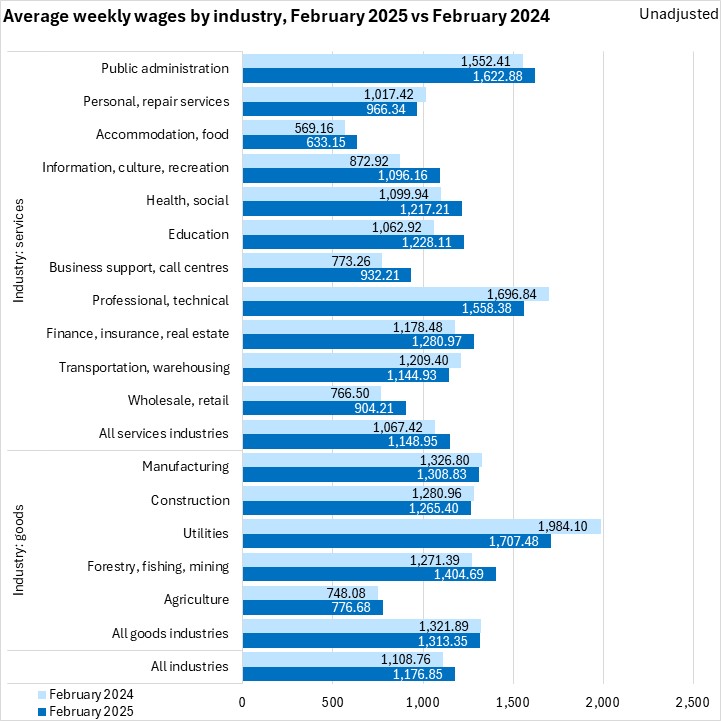
Average weekly earnings (unadjusted, both full time and part time, January-February 2025 vs January-February 2024)
Average weekly earnings increased 6.7% in the first two months of 2025 compared to the same period of 2024. The fastest gains in average weekly earnings were in information/culture/recreation, accommodation/food services, and wholesale/retail. Agriculture registered a notable decline in average weekly earnings in January-February 2025, with smaller declines in utilities and personal/repair services.
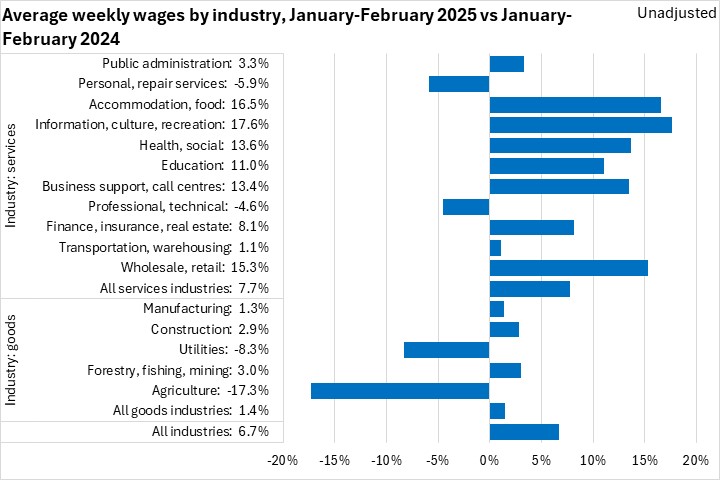
Average weekly earnings in the first two months of 2025 were highest in utilities, professional/technical services, and public administration. The lowest average weekly earnings were in accommodation/food services, wholesale/retail trade, agriculture and business support services (including call centres) in January-February 2025.
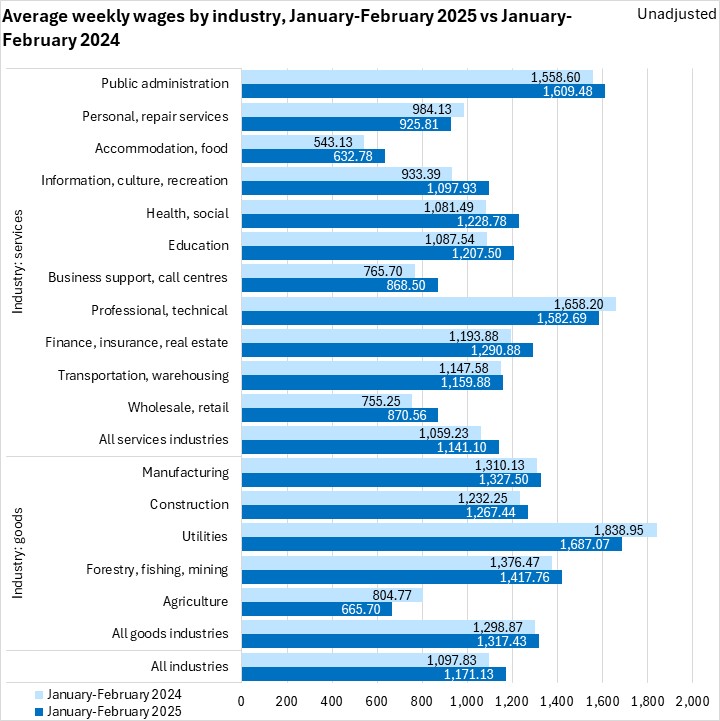
Regions (February 2025 vs February 2024, unadjusted 3 month moving average)
Compared with February 2024, labour force and employment increases were concentrated in Cape Breton and the North Shore, with smaller gains in Halifax. The North Shore and Cape Breton labour force growth outpaced employment growth, resulting in higher unemployment, with falling unemployment rates in all other regions. Annapolis Valley reported lower labour force and employment compared to one year ago, while Southern Nova Scotia saw an increase in employment combined with a matching decline in the labour force. Halifax saw the strongest population growth, and a large increase in the number of people not in the labour force.
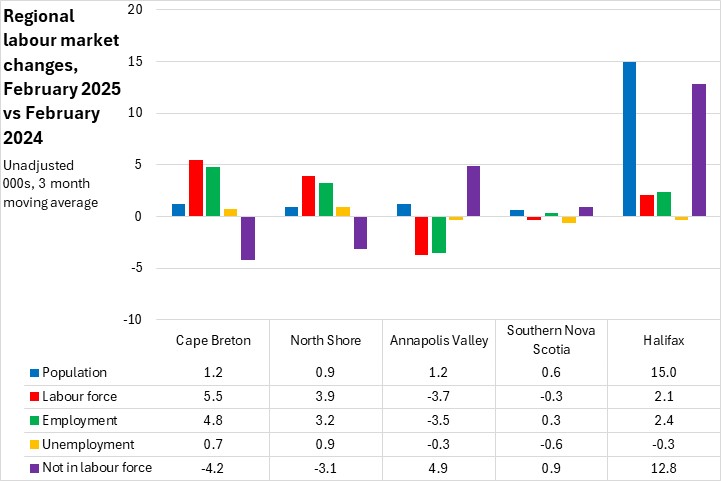
Unemployment rates were up in Cape Breton and the North Shore, and down in Annapolis Valley, Southern Nova Scotia, and Halifax.
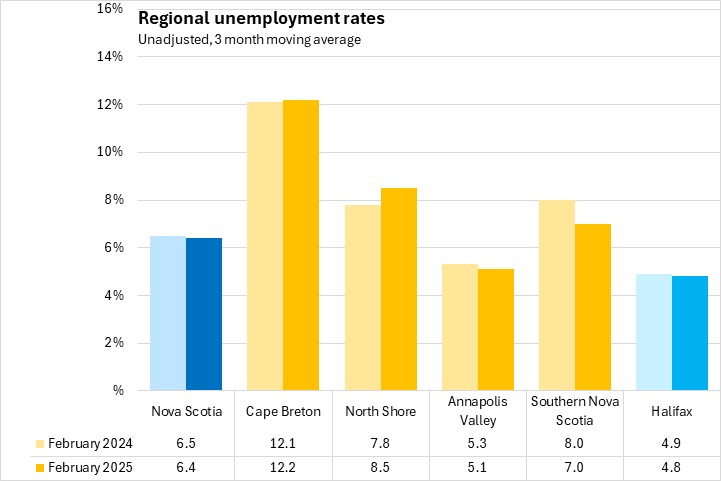
Participation rates rose in Cape Breton and North Shore, and declined in Annapolis Valley, Southern Nova Scotia and Halifax.
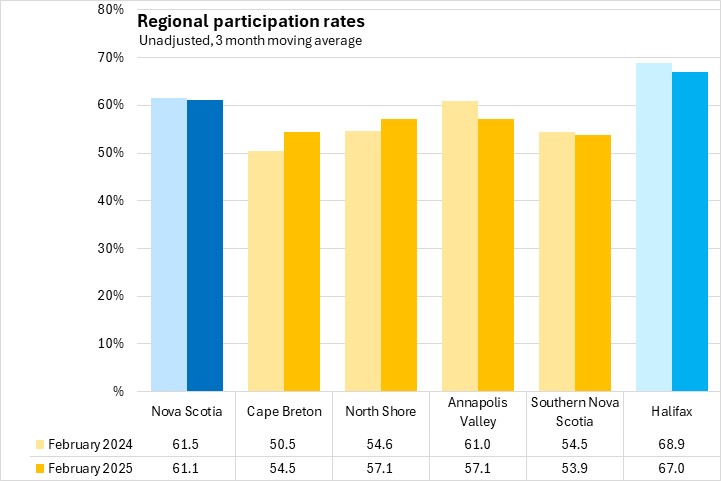
Employment rates rose in Cape Breton and North Shore, and declined in Annapolis Valley and Halifax. There was no change in the employment rate in Southern Nova Scotia.
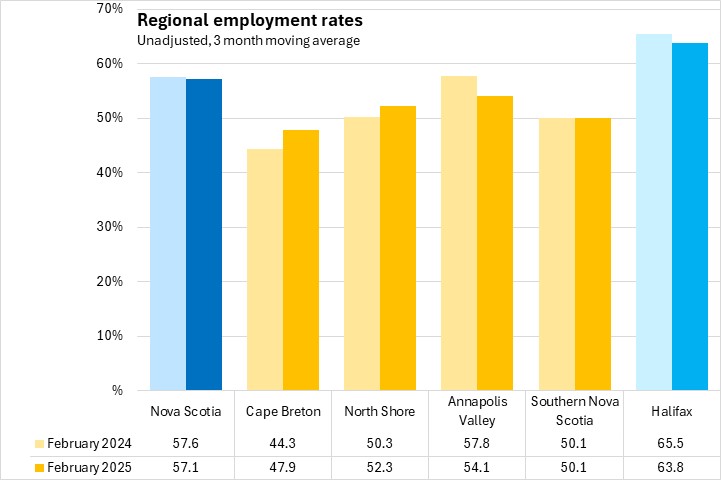
Regions (January-February 2025 vs January-February 2024, unadjusted 3 month moving average)
Compared with January-February 2024, labour force and employment increases were concentrated in Cape Breton and the North Shore, with smaller gains in Halifax. The North Shore labour force growth outpaced employment growth, resulting in higher unemployment, with falling unemployment rates in all other regions. Annapolis Valley reported lower labour force and employment compared to one year ago, while Southern Nova Scotia saw an increase in employment and a decline in the labour force. Halifax saw the strongest population growth, and a large increase in the number of people not in the labour force.
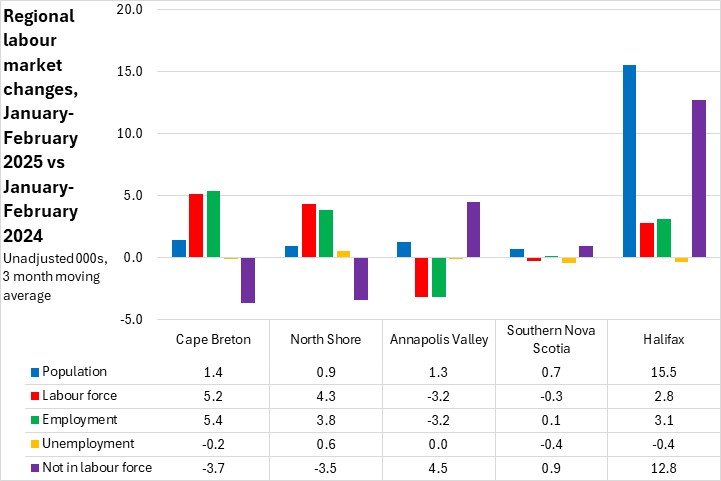
Provincial Comparisons (seasonally adjusted)
Canada's labour force fell 0.1% from January with six provinces reporting declines in February 2025. New Brunswick reported the fastest growth while the largest declines were in Québec and Newfoundland and Labrador.
Compared with February 2024, the national labour force was up 2.6%, with every province except Newfoundland and Labrador reporting increases. Manitoba reported the fastest increase while slowest growth was in Nova Scotia.
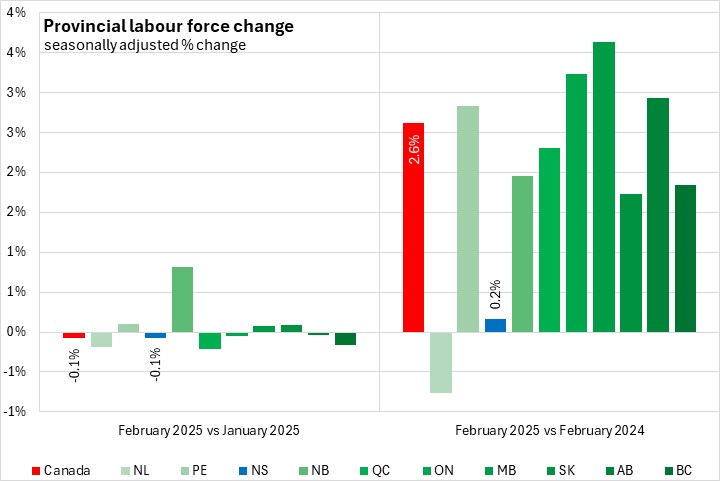
Canada's employment was virtually unchanged from January to February. Seven provinces reported lower employment in February, led by Nova Scotia, while Ontario reported the strongest gain. Compared with February 2024, the national gain was 1.9% with the fastest growth in Alberta and Ontario, and the largest decline was in Newfoundland and Labrador.
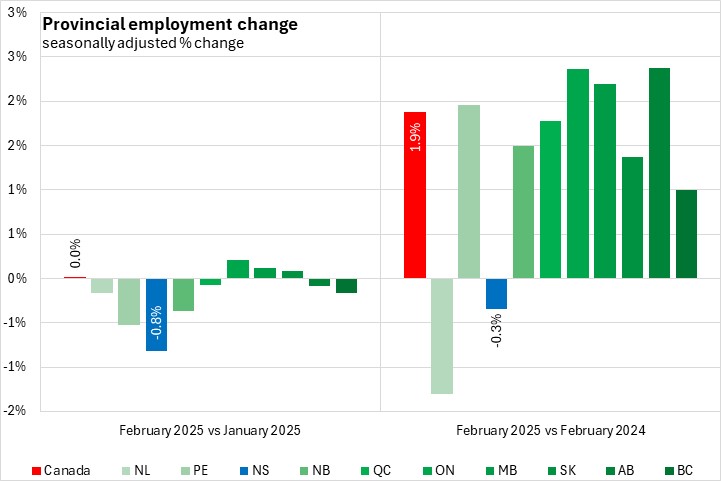
The national unemployment rate was 6.6% in February 2025, up from 5.9% in February 2024. Québec and Saskatchewan had the lowest unemployment rates while Newfoundland and Labrador reported the highest unemployment rate in February 2025.
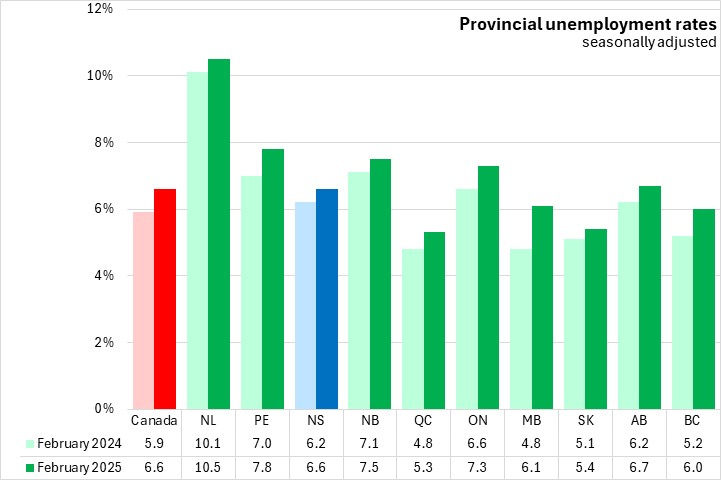
The national participation rate was 65.3% in February 2025. The highest participation rate was in Alberta while the lowest was in Newfoundland and Labrador.
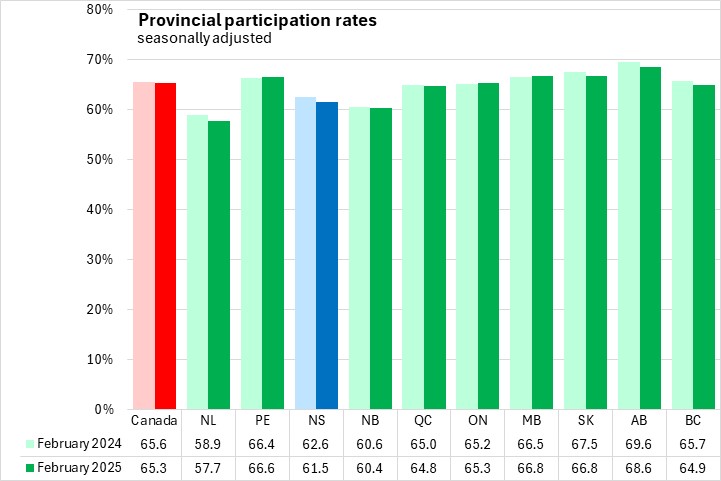
The national employment rate was 61.1% in February 2025. Alberta reported the highest employment rate while Newfoundland and Labrador reported the lowest.
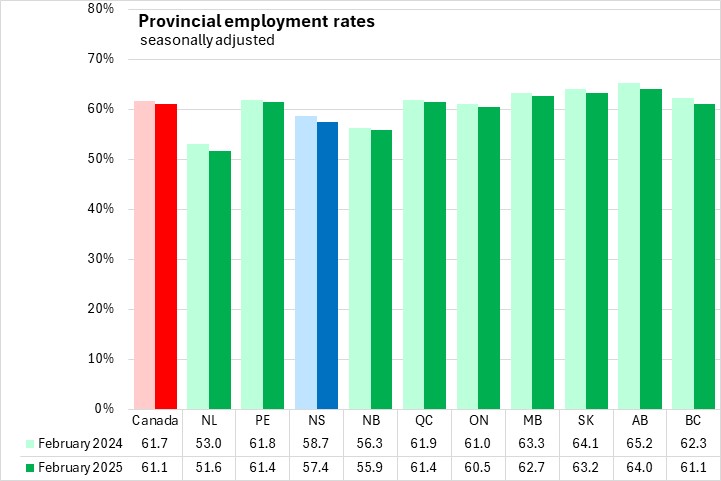
Census Metropolitan Areas (February 2025, seasonally adjusted 3 month moving average)
The Halifax unemployment rate was 5.0% in the seasonally adjusted February 2025 three month moving average. Outside of Halifax the unemployment rate was 7.9%. In central and western provinces, unemployment rates in Census Metropolitan Areas are similar to or higher than unemployment rates outside CMAs. In the Atlantic Provinces unemployment rates are typically higher outside CMAs.
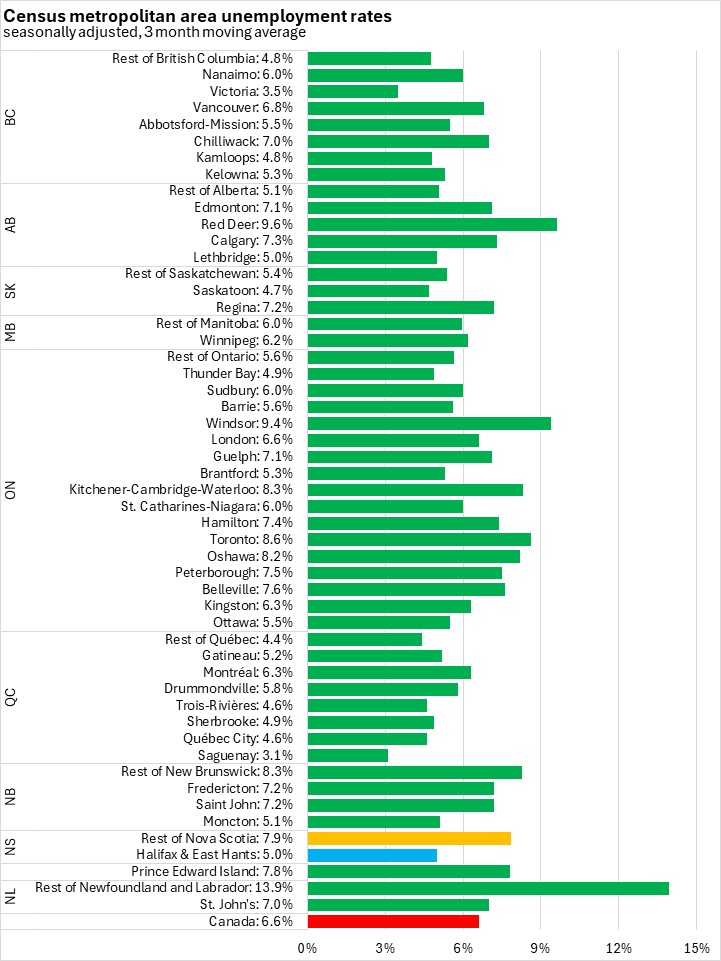
Halifax's participation rate was 67.9% in the seasonally adjusted February 2025 three month moving average, while participation rates were 55.5% across the rest of the province.
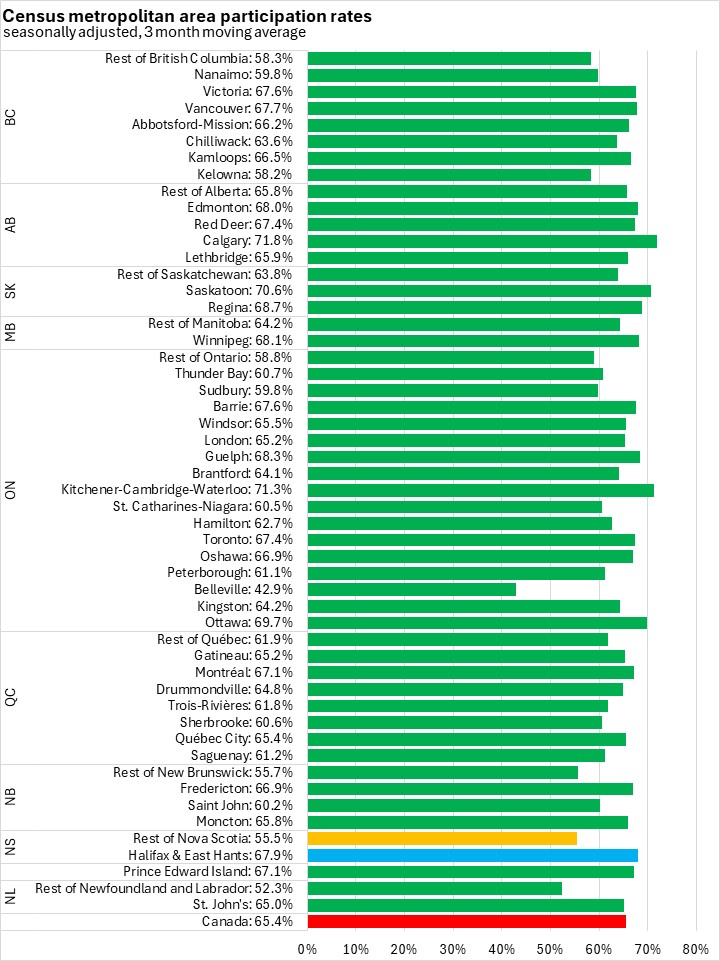
Halifax reported an employment rate of 64.5% in the seasonally adjusted February 2025 three month moving average, while the employment rate was 51.1% outside the city.
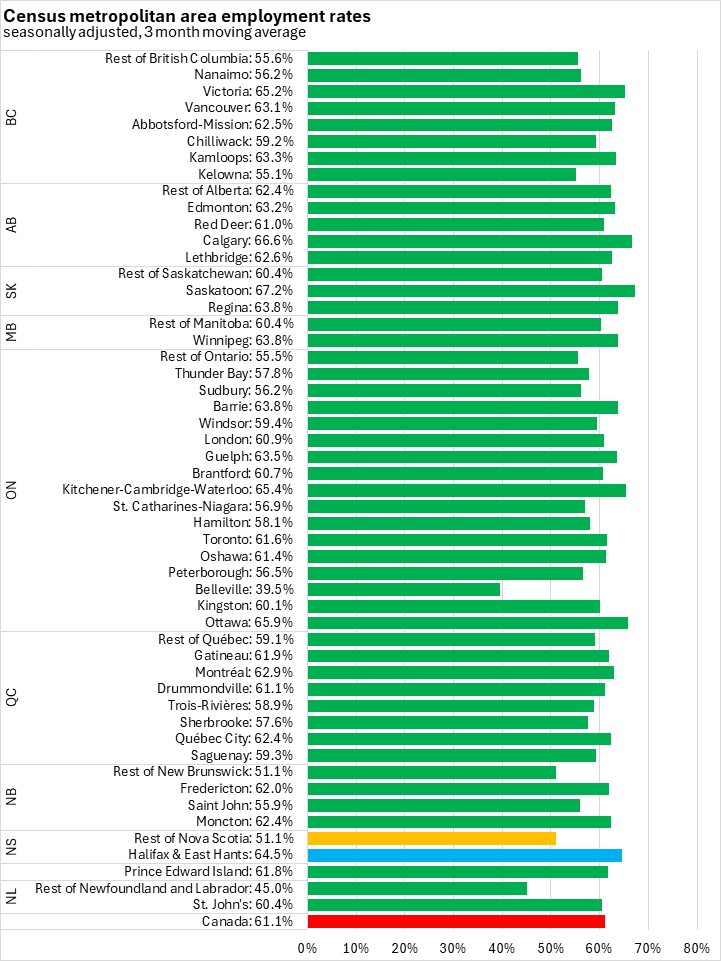
Sources: Statistics Canada. Table 14-10-0036-01 Actual hours worked by industry, monthly, unadjusted for seasonality; Table 14-10-0063-01 Employee wages by industry, monthly, unadjusted for seasonality; Table 14-10-0287-01 Labour force characteristics, monthly, seasonally adjusted and trend-cycle, last 5 months; Table 14-10-0380-01 Labour force characteristics, three-month moving average, seasonally adjusted; Table 14-10-0387-01 Labour force characteristics, three-month moving average, unadjusted for seasonality, last 5 months; Table 14-10-0355-01 Employment by industry, monthly, seasonally adjusted and unadjusted, and trend-cycle, last 5 months (x 1,000); Table 14-10-0288-01 Employment by class of worker, monthly, seasonally adjusted and unadjusted, last 5 months (x 1,000); Table: 14-10-0459-01 Labour force characteristics, three month moving average, seasonally adjusted (x 1,000)
<--- Return to Archive